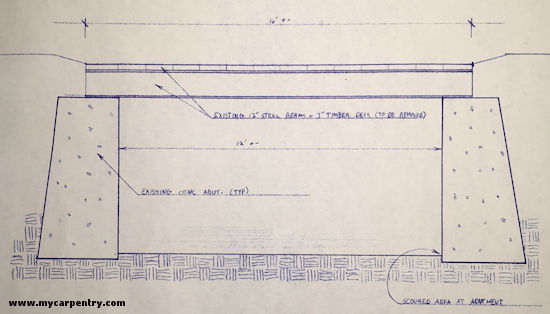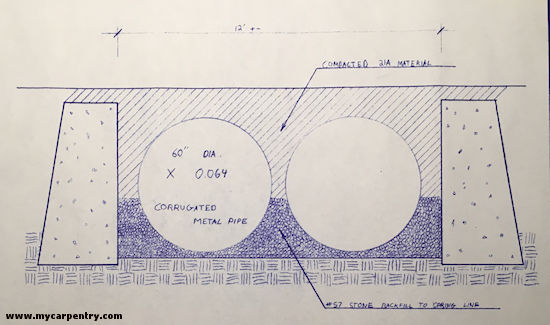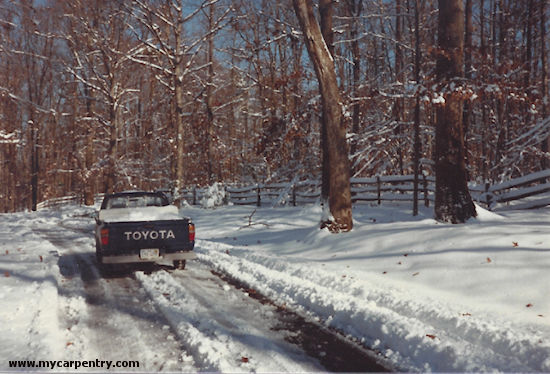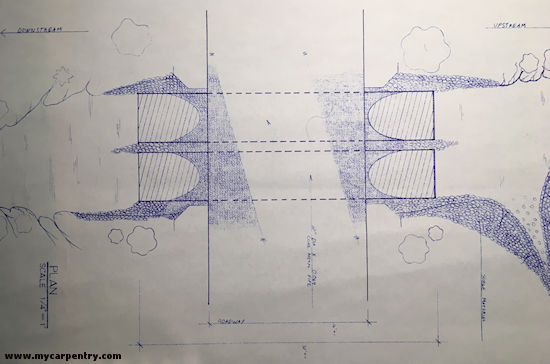Carpentry Beyond Wood
This title is a chapter from a memoir I'm writing about my life as a carpenter—the experiences that inspired mycarpentry.com. While mycarpentry.com is about carpentry, these chapters are about the carpenter.
***
As a carpentry contractor, your construction projects may occasionally require carpentry beyond wood, like concrete, steel, aluminum, sheet metal, industrial plastics, or corrugated galvanized pipe. You can always pay someone to do the non-wood-related tasks, but if you do the work yourself, you can save on subcontractor expenses while you learn the art of working with new materials. You might discover that many of the same building concepts that apply to wood also work for other construction materials.
One of my experiences with the carpentry beyond wood concept began in the summer of 1989 in Clifton, Virginia. As a small-job general contractor, I had established a two-year reputation for designing and building diverse projects in the area. One afternoon, I received a call from Thomas Henderson, the president of a rural homeowner's association, expressing concern about a failing bridge - spanning a small creek - that provided access to seven homes and properties. The structure of the existing bridge consisted of concrete abutments - constructed on opposing banks of the stream - supporting steel I-Beams that spanned the width of the creek and supported the weight of the 4x12 oak planks used for the bridge's surface. The road leading to and from the bridge was #21A gravel. The creek maintained a steady flow most of the year, but after a heavy rain, it could swell to levels above the top of the bridge.
No one living in the subdivision knew the age of the existing bridge. George Washington lived not too far away. Perhaps he used the old bridge back in the 1700s. The bridge was intact, but the soil behind the concrete abutments continued to wash out with each new flood. Another contributing factor, believed by many of the homeowners in the subdivision, was that moles might have burrowed behind the abutments, causing even further erosion.
Carpentry Beyond Wood - Corrugated Galvanized Pipe (CGP)
Thomas Henderson suggested replacing the existing bridge with a culvert pipe because he feared the same thing would happen again if we rebuilt it using the existing design. Replacing the bridge with Corrugated Galvanized Pipe (CGP) would be less expensive and time-consuming. All we would have to do with CGP is to remove the 4x12 planks and the I-Beams and drop the pipe directly into the creek. Since the bridge was the only access to the homes in the subdivision, a speedy job was an essential requirement.
We also needed to determine the diameter of CGP to use. An inadequately sized pipe could wash out in the spring rains. A pipe with a diameter too large would create a hump in the roadway that could ice up in the winter and make crossing the creek difficult. Another factor to consider was weight - the pipe needed to comfortably support the weight of the largest vehicle crossing into the subdivision. After much study, we decided on two five-foot diameter pipes at .064 gauge.
The project took about six months of meetings with the homeowner's association and permitting authorities before finally getting approved on November 15th. That day, I ordered three five-foot diameter pipes, twenty feet long, and scheduled the delivery two weeks later. That put the delivery date near December 1st - the coldest December I had ever experienced. The project deployment date was uncomfortably close to my planned Christmas vacation to Corpus Christi, Texas, on December 19th. But if all went well, I should be able to fly out of Dulles Airport as planned.
The weather took a severe turn for the worse. Before Thanksgiving, we received approximately six inches of snow on top of the snow that had fallen nearly every day for almost two weeks. The pipe arrived on schedule, but the severe cold and a foot of snow on the ground made working conditions torturous, so we decided to wait for the weather to improve. We waited and waited. Yes, conditions changed. They got worse. Temperatures were sometimes near zero degrees with unimaginable wind chills.
Our Plan
On Sunday, December 17th, I met my partner, Aaron, on the job site to inspect the creek and working conditions. Aaron was a skilled heavy equipment operator and general construction worker. His common sense approach to solving problems and his die-hard persistence made him an indispensable worker to have around on jobs like this. The creek would soon freeze, making the job grueling, if not impossible, until it thawed sometime in the spring. There was still water flowing under the icy surface, so we decided to start work the next day. The condition of the existing bridge was questionable, or we would have waited for better weather.
To prepare for job day, we ordered a load of #57 stone to use as a foundation for the corrugated pipe and a few loads of #21A gravel to build up the road over the CGP. We rented a large backhoe to help demolish the wooden bridge and to carry the heavy banded sections of CGP from a nearby pasture to the creek bed. We scheduled the backhoe and gravel to be delivered early the next day.
Aaron and I looked at each other with raised eyebrows, wondering if we were making the right decision - exposing ourselves to severe cold and icy conditions. We decided to buy some beer and head over to Aaron's garage to create a list of the tools we would need and to discuss the job day schedule. We drank two beers each and left the remaining full cans on his workbench, thinking the chilly weather would keep them cold.
Afterward, I drove home and prepared for sleep. While lying in bed, I got nervous thinking about our work schedule. What if the gravel does not get delivered? What if the forklift doesn't show up? What if we cannot finish the job in time for the homeowners to travel in and out of their subdivision for work and whatnot? After about 30 minutes, I drifted off into a deep sleep.
On Monday, December 18th, I woke up at 3 am thinking about the tremendous job I was facing and that I was only about 26 hours away from flying home to Texas for Christmas. If we get lucky, I thought, this job could wrap up early, and I could still make my flight. It was too late to reschedule and receive a refund for my plane ticket.
Job Day
At 5 am, I got out of bed and put on a pot of coffee. It was job day, and it was time to get moving! I looked at the thermometer I had mounted outside my window, 22 degrees - somewhat warmer than it had been since the beginning of the month. I knew that dressing for the extreme cold was imperative. I drank some coffee and jumped in the shower. I took a hot, steamy one, thinking it would be the last time I would be warm that day. What to wear? I started with a pair of silk Long Johns that are supposed to be better than standard cotton thermals because you don't sweat under them (so they say). Then, I put on a thin pair of cotton socks covered by wool socks, a t-shirt, jeans, a cut-off sweatshirt, an insulated flannel shirt, and some insulated rubber work boots. All this clothing was to be covered by insulated coveralls and a heavy jacket once I got to the job site. I filled my thermos with coffee, grabbed my coveralls and heavy coat, and was on the road before dawn.
On the last curve of the road - before arriving at the job site - I noticed two piles of gravel. The #21A and #57 were delivered. Good, I thought, one less thing to worry about. Aaron was already on site, leaning against his solid black Ford pickup, drinking coffee and smoking a cigarette in the crisp morning air. I parked my Toyota truck nearby, rolled out of the driver seat with all my heavy clothing, and began walking toward him.
"Cold enough fer ya?" I asked, speaking with an exaggerated country accent.
"Hell no! Bring it on!" he replied with a chuckle.
"You just keep telling yourself that Bozo," I said, continuing the accent, "It is colder than a well-diggers ass out here, and it aint likely gonna get better!"
He wore similar clothing. We laughed at each other for being bold enough (or stupid enough) to work in such extreme wintry conditions. We talked about the project, shivered, told jokes, and drank coffee for about fifteen minutes until the backhoe arrived. We unloaded it from the flatbed trailer and went to work.
I had ordered three 20-foot pipes. I planned to use two pipe sections side-by-side. The third pipe was to be cut in half and banded to the two 20-footers to make two 30-foot pipes. I needed the 30-foot lengths so that the gravel on the 16-foot wide roadway would not be too steep on either side of the road and so that the ends of the pipe could be left exposed.
All morning and afternoon, it was sunny and calm. It got too warm for my heavy coat, so I worked in my coveralls for a few hours. We felt good working in the snow, and the job was going according to plan.
Removing the Old Bridge
While I was cutting one of the pipes in half with a torch, Aaron used the backhoe to remove the oak planks from the bridge and expose the I-beams. We were surprised at how difficult it was to remove the I-beams from the concrete abutments. The I-Beams were secured to the abutments better than we thought. I put the banding material on the pipe sections, bolted them down, and then wheeled the torch to the bridge to cut out the I-Beams. We cut and removed two of the smaller I-Beams, but it was taking too long. On the larger beams, the melted steel solidified on the cut before falling to the ground, thus re-welding the I-beam as fast as I could cut it. We finally ran out of oxygen and acetylene. I suggested we rent a quickie-saw and a couple of blades to cut out the I-Beams. We drove Aaron's truck to Fairfax and picked up the saw we needed from a tool rental company. We decided to take a break and eat hamburgers for dinner before returning to the creek. It was about 4 pm and getting dark and cold. On the way to the job site, we passed a bank sign with a scrolling message below - No Monthly Service Fees and No Minimum Balance Requirements... 15°F... Merry Christmas! We realized we would be working well into the evening and began to get a little nervous about our schedule.
We returned to the icy creek about sundown, gassed up the two-cycle saw, and started cutting the steel I-Beams. It worked well and sparks from the metal made a dazzling display against the snow-covered ground and night sky. Thomas and some of the homeowners came out to watch the light show.
"We should charge admission," I said. (audible enough for the homeowners to hear).
"Yeah, maybe we could make a little extra beer money!" Aaron added.
Everyone laughed. The homeowners seemed surprised by our good spirits.
After a couple of hours of cutting, we removed the last I-beam and were ready to prepare the creek bed for the corrugated galvanized pipe. At this point, the homeowners, except for Thomas, had decided the inclement wintry weather was too much and retreated to the toasty comfort of their homes.
Preparing the Creek Bed
We chose to bury the concrete abutments with the new culvert pipe under a thick layer of compacted fill. We used the backhoe to break up the frozen surface of the creek so we could add a layer of #57 stone to the creek bed. We used the #57 gravel as a base for the pipe to make it easier to grade the creek bottom. Once we prepared the creek bed, it was time to install the two 30-foot pipe sections. The 30-footers were lying in a pasture on the other side of a barbed-wire fence about 100 feet away. Aaron drove the backhoe across a frozen cattle guard and maneuvered the machine into position in front of the first pipe. We chained the first CGP to the backhoe, with some support in the middle to keep the sections from coming apart. Aaron lifted the first pipe, but the banding broke. We decided to take the pipe sections one at a time and band them together in the creek. The 20-foot pieces of pipe weighed 1500 pounds each, which was nothing for the backhoe, but the bulk of the five-foot diameter pipe made them hard to manage. Banding the CGP in the creek meant I had to wade through about 8 inches of freezing water. Thomas was watching me from above.
"My mother taught me better than this," I said.
"I am sure she did, Matt," Thomas replied with a smile.
We placed the pipe sections in the creek, banded them together, and got them positioned in place around 11 pm. We could see that our long day was coming to a welcomed end. Aaron hopped on the backhoe and began filling the space between the pipes with the remaining #57 stone, and then proceeded to add the #21A gravel on top of the CGPs while I tried to locate our tools in the deep snow and darkness.
Aaron added just enough gravel to provide pedestrian access across the creek (the minimum goal for the day). Around midnight, the cold was becoming unbearable.
"You guys did a great job today," Thomas said. "I am heading inside where it is warm. I suggest you do the same."
"Thanks, Thomas!" I said. "Have a nice evening."
"You too, Matt and Aaron," he said as he walked briskly toward his house.
"Well, what do you want to do, Aaron?" I asked.
"For now, I say we get in my truck and warm the hell up," he replied.
"That sounds good to me too."
We got in his truck, fired up the heater, and turned on the radio to discover that the temperature had dropped to 1° at Dulles airport (that is right, Dulles, the very airport that I should be at in less than 6 hours, to get to the ticket desk, check-in, and take my seat on the 7 am DC10 headed for Dallas).
Missing My Flight
After we got warm, we could not imagine getting back into the cold, with at least two more hours of work ahead of us to finish the job. We were exhausted. We decided to call it a day and return in the morning to finish up. Well, that was it. I had just decided to miss my flight. We packed the tools we could find in the deep snow and drove down the icy roads to Aaron's garage. When we arrived, we remembered the cans of beer we left on Aaron's workbench and decided to have one. The beer had frozen solid. Aaron put the beers in the kitchen sink under hot water while we finished unloading and stowing the tools in his sub-zero garage.
Warm Beer
After a while, we checked the beer in the sink. Sure enough, we left the beers under the hot water too long! They went from being too cold to too hot, but they tasted good and might even have been among the tastiest beers I have ever had - especially after a long day in the bone-chilling cold.
At about 2 am, I left Aaron's house and turned the heater in my truck full-blast to try and break the spell of the blistering winter night. I never told Aaron about my flight to Texas. I am sure he would have been okay with finishing the job by himself, but it was not his responsibility to do that. It was mine. I needed to see the job through to the end, and I knew it.
Finishing the Job
Aaron and I met at the job site at 8 am the next day, allowing ourselves a little sleep-in time. The skies were overcast, and light snow was beginning to fall. He started the backhoe and began spreading the remaining stockpile of #21A gravel over the pipes. The pipe manufacturer required a minimum of 18 inches of #21A on top of the GCP to evenly distribute the load from vehicles crossing above. We agreed that we did not have enough gravel to cover the pipe, so we ordered two more truckloads. We finished the job around 3 pm and gathered the tools we could not find the night before.
To put a cap on the project, we shared a few beers and smoked cigarettes in the chilly air while we discussed the details of our carpentry beyond wood experience. We watched the creek flow smoothly through the new corrugated pipe. It was a magnificent sight. After we finished our beer, Aaron left to meet his father for their annual holiday hunting trip, and I headed down the snowy road back to my home in Centreville. On my way, I stopped at a grocery store and bought a big steak to celebrate the end of a successful job.
Once home, I removed my coat and coveralls and had broiled steak, potatoes, and hot apple cider for dinner. I looked around and realized I had not decorated my apartment for Christmas. Since I am spending Christmas in Virginia, I should make the most of it. After dinner, I found a string of colored mini-lights in a cardboard box and strung them across the ceiling. As I enjoyed the glow of the lights and the warmth of my living room, I could see snow accumulating on the leafless limbs of oak trees growing outside my window. Soon, the remaining light of the day turned to darkness, and I headed for sleep.
After that day, I knew that, no matter how many construction jobs I would work on over the years, I would never forget replacing the old bridge in the frozen waters of Castle Creek, Clifton, Virginia. 1989
~Matt
What next?
Leave Carpentry Beyond Wood and visit our home page.





